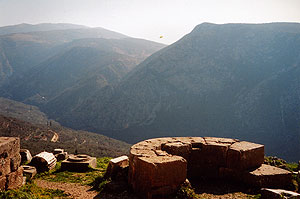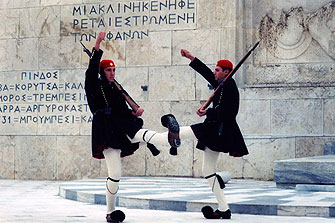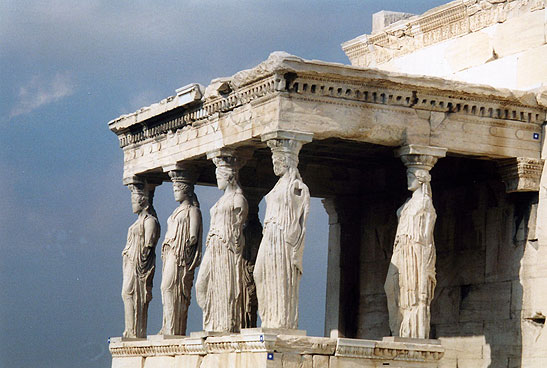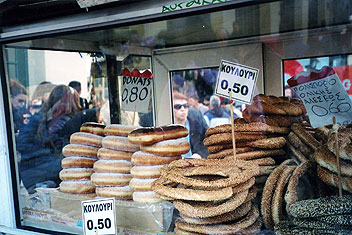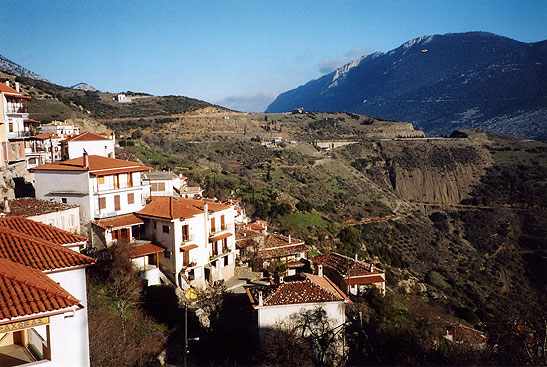 |
 |
|
 |

|
Athens
Story and photos by Corinna Lothar
The place is Athens during the Halcyon days (named for Alcyone) in mid-January, the warm, sunny weather seems more like spring than winter. A perfect time to visit the land of the ancient gods: tourists are scarce and restaurants and museums are not crowded. The cool weather can be delightful, never too hot and occasionally refreshed by rain showers. The mountains are dusted with snow - -- Greece has ski resorts --- but Athens and the surrounding area profit from the kindness of the god of the winds.
The elegant old Grande Bretagne Hotel, recently renovated, stands on the square, too, with a fine bar for a drink. The Syntagma metro station is worth a visit, even if you aren't going anywhere. It's decorated with stunning antiquities unearthed when the station was built.
The statues on view today are copies; the original five sculptures of the beautiful maidens are in the Acropolis Museum located below the Acropolis where the original sculptures, reliefs and other art works from the Acropolis buildings are on view. A sixth, along with the Elgin marbles, is in the British Museum in London. Inside the temple was the 40 foot high statue of Athena made of wood, ivory and gold, the work of the sculptor Pheidias. The statue was lost during the Byzantine era, but a smaller Roman copy survives in the ever-fascinating National Archaeological Museum, which offers visitors not only a wealth of art from Greece's classical period, but a magnificent collection of cycladic art. On the southern slope below the Acropolis lie the ruins of the Odeon of Herodes, built in 161 A.D., and the Theatre of Dionysius, where Aeschylus, Aristophanes, Euripides and Sophocles saw premiere performances of their plays in the 5th century B.C. In the summer, the theatre is used for plays, and concerts are performed in the Odeon. Farther down the hill to the southeast stands Hadrian's Arch, the entrance to the huge Olympian Temple of Zeus. Only 15 of the original 104 Corinthian columns of the temple remain. It was dedicated by the Roman emperor Hadrian in 132 A.D. He erected a gold and ivory inlaid statue of Zeus in the temple, and next to it he placed a huge statue of himself. Neither survives. The Arch marks the boundary between the ancient city and the new. On the side facing the Acropolis is inscribed "This is Athens, the city of Theseus." On the side facing the Temple of Zeus, it states, "This is Athens, the city of Hadrian." At the foot of the Acropolis to the north lie the ancient Greek agora, the well preserved Temple of Hephaestos, the curious Tower of the Winds (a first century B.C. octagonal hydraulic clock with a bas relief of one of the eight winds sculpted on each face of the clock) in the Roman agora, and the oldest sections of Athens - the Plaka and the Monastiraki. Every Sunday all of Athens seems to wander through the flea market of Monastiraki. The small shops lining the narrow streets are open every day, and on Sunday, the sidewalks are crowded with vendors of all sorts of goods old and new. Restaurants seat Sunday crowds at tables on the narrow sidewalks.
Nearby, on Aghias Theklas Street, is the shop of Athens' famous poet and sandalmaker, Stavros Melissinos. Stavros retired in 2004, and his son, Pantelis, a poet and playwright, now makes the sandals and runs the shop. Lord Byron lived in a house on this street when he visited Athens in the 19th century. Athens' large, busy Central Market bustles in the Psyrri quarter adjacent to Monastiraki. Fruit, vegetables, meat and fish are colorfully displayed and vendors shout their wares from booths. Dozens of different fish are often displayed with miniature boats and shells, with whole lamb carcasses hanging above the butchers' wares. Day trips from the city offer a visitor the opportunity to admire beautiful countryside and to visit the ancient sights or some of the islands. Regularly scheduled bus and boat tours with knowledgeable guides, fluent in English, make the visits easily accessible. Rental cars are available but finding a way in and out of Athens can be difficult. Several of the trips are available only during the summer season between April and October; others run all year. One such year-round trip goes from Athens into the Peloponnese, reached by crossing the narrow Isthmus of Corinth via the bridge high across the Corinth canal. The canal was begun by the emperor Nero but not completed until 1893. Corinth Ancient Corinth was dedicated to Aphrodite, the goddess of fertility. A thousand women served the goddess as sacred prostitutes for rich visitors, earning money for the temple. Corinth earned a licentious reputation, and St. Paul preached in the city against its wickedness; his letters to the first Christian congregation became the books of the Bible called I and II Corinthians. Corinth's acropolis, Agrocorinth, lies 1500 feet above sea level and 1000 feet above the ancient city. The ruins are reached through three gates, each dating from a different century. It has served as a fortress for each conqueror of Corinth. Mycenae & Epidaurus The important Mycenaean civilization existed from about 1600 to 1100 B.C., when Mycenae was abandoned. The ruins of the fortified palace are grandiose. This was the home of the house of Atreus, from whence Agamemnon set forth in 1250 to Troy to avenge the theft of his brother's wife. It's a climb from the parking lot up the hill and through the fabled Lion Gate, the first example of European monumental sculpture. Grave circles within the walls hold the tomb of Clytemnestra. At the top, all that is left are the outlines of the chambers of what was a mighty palace. The view, like the ruins, is unique. The hilltop palace was inhabited by the ruling class, while the merchants and artisans lived and were buried below, outside the walls. Nearby is the treasury, or beehive tomb, of Atreus, an extraordinary circular burial chamber with a high dome and a single straight entry passage lined with stones. The entrance itself is surmounted with a 120 ton lintel stone; the dome is entirely covered by earth. Unlike their contemporaries, the Mycenaeans did not cremate their dead, but buried their kings with weapons and food for the journey to the other world. The tomb is also called Agamemnon's, whose golden death mask is on exhibit in the Archaeological Museum in Athens. Nafplio Palm trees, water gently lapping against the harbor promenade, small shops and restaurants, a large central piazza with outdoor cafes, and flowers blooming in the winter sunshine give the town a Mediterranean air. The town's Catholic churches were built originally as mosques by the Turks. A genuine Italian gelateria adds the perfect conclusion to a delicious lunch of mezze, washed down with a glass of good Greek wine and later a tiny cup of strong, sweet Greek coffee. Athenians come to Nafplio for a weekend of sun and relaxation. The town's proximity to Epidaurus and its summer drama festival makes it particularly attractive as a place to overnight. Epidaurus Delphi Delphi, the navel or center of the world in Greek mythology, is magnificent. There, the sibyl in her laurel smoke enduced trance would mumble prophecies from her tripod atop the sacred rock. A crack in the rock emitted the fumes surrounding the Pythia, as she was called. The priests would ask a question and interpret her answers in writing, but written without punctuation so that the prophecy, believed to have come from Apollo, could be read in several ways. The oracle was never wrong. The site --- when devoid of school groups and tourists --- is both spiritual and sensual in its peace and beauty, the ruins ringed by mountains that come together like an upside down triangle. Apollo's temple amidst fragrant trees and bushes, overlooks a valley planted with four million olive trees, which even in ancient times produced olives for cooking and oil for lighting. Beyond sparkles the sea. The Sacred Way, climbing from the entrance of the sanctuary to Apollo's Temple, was once lined with 300 statues and treasuries. On the way is the navel stone, representing the center of the earth where two eagles met, released by Zeus one from each end of the world. On the hill above the temple of Apollo is the theatre which could seat 5,000 people. Beyond, is the well preserved stadium where the Pythian Games were held every four years. 7,000 spectators could watch the track and field events and listen to poetry and musical performances. On the hill below the sanctuary is the tholos, a 4th century circular construction, purpose unknown, which was once surrounded by 20 columns. Three columns have been erected to give visitors a sense of what the tholos looked like in ancient times. Outside the sanctuary, on the side of the modern road, is the icy cold Castalian Spring, where anyone visiting Delphi was required to purify himself. The sybil would wash here before making her pronouncements, as did Lord Byron in the hope of divine inspiration for his poetry. Delphi's museum is a treasure trove of sculptures, friezes and architectural remnants from the sanctuary, including the famous bronze sculpture, the Charioteer. There are many other places that can be visited in a day trip from Athens, such as the temple of Poseidon on a rock at Cape Sounian overlooking the Aegean Sea, or a boat trip to one of the islands. The trip to Meteora and the monasteries built on rocky formations requires a second day. WHEN YOU GO Accomodations: Athenaeum Intercontinenal Hotel Sightseeing: General Information: |
|
I found a Mich Goss J. Grassmayr Innsbruck bell with Jesus,
a crucifix and a flower on it. Do you have any information about it you can
share with me? Many thanks. I don't have any information on that specific bell. If she wants information, "Liz" in San Bernardino should contact the factory. Here is the information: Address Grassmayr Foundry and Bell Museum, Leopoldstrasse 53, Inssbruck, A-6010 Austria. Telephone: 43 512-59416-0. Fax: 43 512-59416-22. E-mail: johannes@grassmayr.at or info@grassmayr.at. Corinna
Been there -- thought I'd done it -- you proved me wrong. Great travel coverage -- even for those who have lived there. --- Bill, Redmond, Oregon
Corinna, my dear, What a wonderful series of words you have collected together to paint a mesmerizing story about one of my favorite places. Even though I've traversed these same locales as you many times, your delightful descriptions made me want to book a flight this very second and see again some of the places that time did not allow me to linger in before. Your photos are also riveting, and I loved the pantyhose one - what a clever, sexy way to promote that article of the female form. Your colorful words make the entire region literally come alive before my eyes - a rare gift for any writer! Bravo and again Congrats on your top notch feature. Best regards. Best regards,
Hello Corinna, This is very roundabout ... I was recently teaching (Legal Reasoning) in Kabul and encountered Ann Geracimos, who said she knows you from the Times. She recently provided me with an electronic version of your 2007 piece about returning to Frankfurt (which I enjoyed very much). Jonelle and I are well (and enjoying our 3 grandchildren, who live within blocks of our house). I hope you are well. I will now look for your travel writing regularly. Best regards,
What an amazing background Ms. Lothar has! I enjoyed her article
very much. I found it to be quite intriguing, especially the interpreter school
bit.
I loved your article on Metz. I was an exchange student living there from 1981-1982 and have always felt like Lorraine was the most overlooked part of Europe. You really captured the feel of the city with your photo and articles.
|
![]()
Stay tuned.
This site is designed and maintained by WYNK Marketing. Send all technical issues to: support@wynkmarketing.com



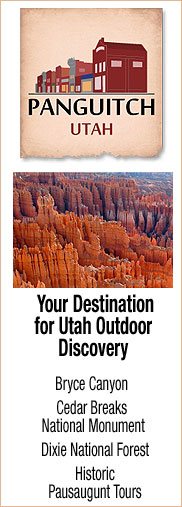








 anuary
is heavenly in Greece. According to Greek mythology, Alcyone, the daughter
of the king of the winds, married Ceyx, the son of the Morning Star.
When Ceyx drowned in a storm at sea, Alcyone was so distraught that
she threw herself into the sea in grief. Out of compassion for the loving
couple, the gods changed them into kingfishers. In order for Alcyone
to be able to make her nest and lay her eggs on the beach in peace,
her father restrained the winds and calmed the waves for a short period
each January . A lovely story; a lovely time of the year; a lovely place.
anuary
is heavenly in Greece. According to Greek mythology, Alcyone, the daughter
of the king of the winds, married Ceyx, the son of the Morning Star.
When Ceyx drowned in a storm at sea, Alcyone was so distraught that
she threw herself into the sea in grief. Out of compassion for the loving
couple, the gods changed them into kingfishers. In order for Alcyone
to be able to make her nest and lay her eggs on the beach in peace,
her father restrained the winds and calmed the waves for a short period
each January . A lovely story; a lovely time of the year; a lovely place.